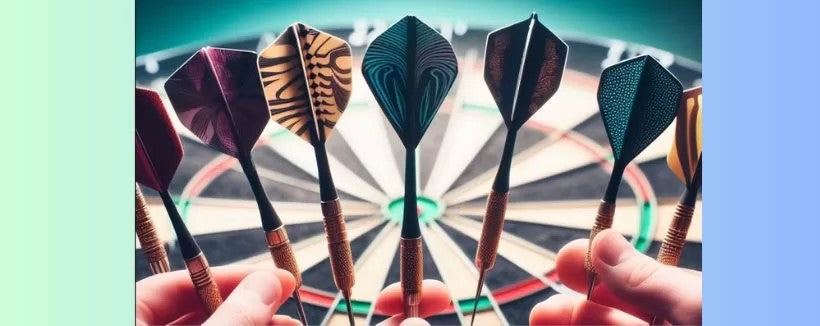
The Ultimate Guide to Choosing Your First Set of Darts
Share
Many thanks to Darts Dave for allowing us to reproduce his article.
Darts is a great game that anyone can enjoy no matter their ability. But how do you know which darts to buy as a beginner? In our ultimate guide to choosing your first set of darts we will guide you through the process.
Ultimate Guide to Choosing Your First Set of Darts
There are many factors to consider, such as the type, material, weight, and shape of the darts. In this article, we will help you find the best darts for your skill level and playing style.
Price: How much should you spend on a beginner’s set of darts?
The price of darts can vary widely, from a few dollars to hundreds of dollars. But does the price reflect the quality? Not necessarily. Don’t see price as the most important factor when choosing darts. What matters more is how the darts feel in your hand and how they fly in the air and price doesn’t come into this. A more expensive dart isn’t automatically going to improve your game.

What makes a set of darts more expensive?
Of course, more expensive darts can be better made and use higher quality materials. They can also be thinner and more durable, which can improve your accuracy and consistency. More often than not, the price is determined by how complex the cuts or grooves are for the machines that make them. These complex features determine the cycle time of each barrel in the machine, and as with many things the longer it takes the more expensive something becomes.
There are many darts on the market where the machine time isn’t that long, but using paint and coatings the darts are made to look flashy. This results in overpriced darts which don’t offer any real benefits to the thrower.
On the other hand, cheaper darts will often have less grip and will just come in the plain “natural” metal colour. Due to cheaper metals they can also wear out faster and need more frequent replacement. But they can also be good enough for casual players and beginners who want to experiment with different styles and weights.
Cheap darts or expensive darts
Ultimately, the best darts for you are the ones that suit your budget and your personal preference. Don’t worry about what others think or what the pros use. You will be judged by your skill, not by your wallet. Hopefully our ultimate guide to choosing your first set of darts helps you hit the bullseye!
What factors determine the price of darts and what do I need to consider when buying
As mentioned the cuts/grip and “flashiness” are key factors that add to the price label. Let’s take a look at the other factors for choosing your first set of darts.
Material: What are darts made of?
The material of the dart barrel affects its weight, size, strength, and feel. The most common materials are brass, tungsten (Wolfram), or stainless steel.
Brass darts, stainless steel darts, Tungsten darts
Brass barrels are usually the cheapest option, but they are not very strong. Stainless steel barrels are stronger than brass, but cost more. Tungsten barrels are favored by professionals because of their high density. Tungsten is a heavy metal and it’s percentage used can allow for thinner barrels without losing weight. This means you can throw the darts with tighter grouping, in turn hitting more doubles and triples.
How do you know what weight darts to use?
The weight of the dart is a personal preference that depends on how you throw it. Generally, heavier darts fly straighter and require more accuracy, while lighter darts fly in a curve and are more forgiving. Therefore, beginners usually prefer lighter darts, while advanced players opt for heavier ones. Of course lighter darts can be more affected like by factors such as a draught in the room.
However, there is no fixed rule and you should experiment with different weights until you find what suits you best. Depending on if you are playing steel or soft tip darts, the common dart weights range from 16 to 26 grams. The vast ,majority of steel tip professional players use darts between 20 and 24 grams, with Ryan Searle being very much an exception using his Loxley 34 gram custom darts. In the PDC the maximum weight allowed is 40 grams but you can also find darts up to 48 grams for sale.
We recommend 23 gram tungsten steel tip darts for beginners as these are the most popular and therefore more to choose from, and 23 grams allows the option to adjust up or down later.
Which darts length and shape for a beginner?
The length and shape of the dart barrel affect how you grip it and how it flies. Darts come in various shapes and sizes, from short and fat to long and thin. The size of your hands and the number of fingers you use to hold the dart will influence your choice of barrel length. Generally, the more fingers you use, the longer the barrel you need. However, if you like to rest your fingers on the tip, you might prefer a shorter barrel.
The length of the barrel also affects the weight distribution of the dart. A longer barrel will tend to have the dart weight more evenly distributed , while a shorter barrel will make it more front-heavy. The shape of your dart also plays a role in this aspect. The weight distribution of your dart will influence how it flies and how it lands on the board.
Professional players usually use slimmer barrels because they can fit more of them in a tight space. As your accuracy improves over time, you might want to consider this option. For now, just go with what feels comfortable.
How much grip should a dart have?
The grip is the texture of the dart barrel that helps you hold it securely and prevent slippage. Dart manufacturers use different methods to create grip, such as grooves, cuts, ridges, and bumps. The grip can vary from smooth to rough depending on your preference.
Typically, the rougher the grip, the better the hold you can achieve. Knurled rings are one example of a very rough grip that provides a lot of friction. However, there is a downside to this as well. A rough grip can sometimes make the dart stick to your fingers when you release it, which can affect your accuracy. We have found that some of the most grippy darts are actually smooth darts. Whilst counterintuitive perhaps, a smooth dart will often allow the skin’s natural oils or sweat to give a more natural feeling grip. Also, the longer you use a smooth dart the grippier they become due to pitting (damage to the barrel from bouncing off of each other).
Summing up the ultimate guide to choosing your first set of darts
We hope our Ultimate Guide to Choosing Your First Set of Darts has helped you on the way in your darts journey. Remember that there is no one-size-fits-all solution and that you should try different options until you find what works best for you. Let us know in the comments if you have found this useful.
